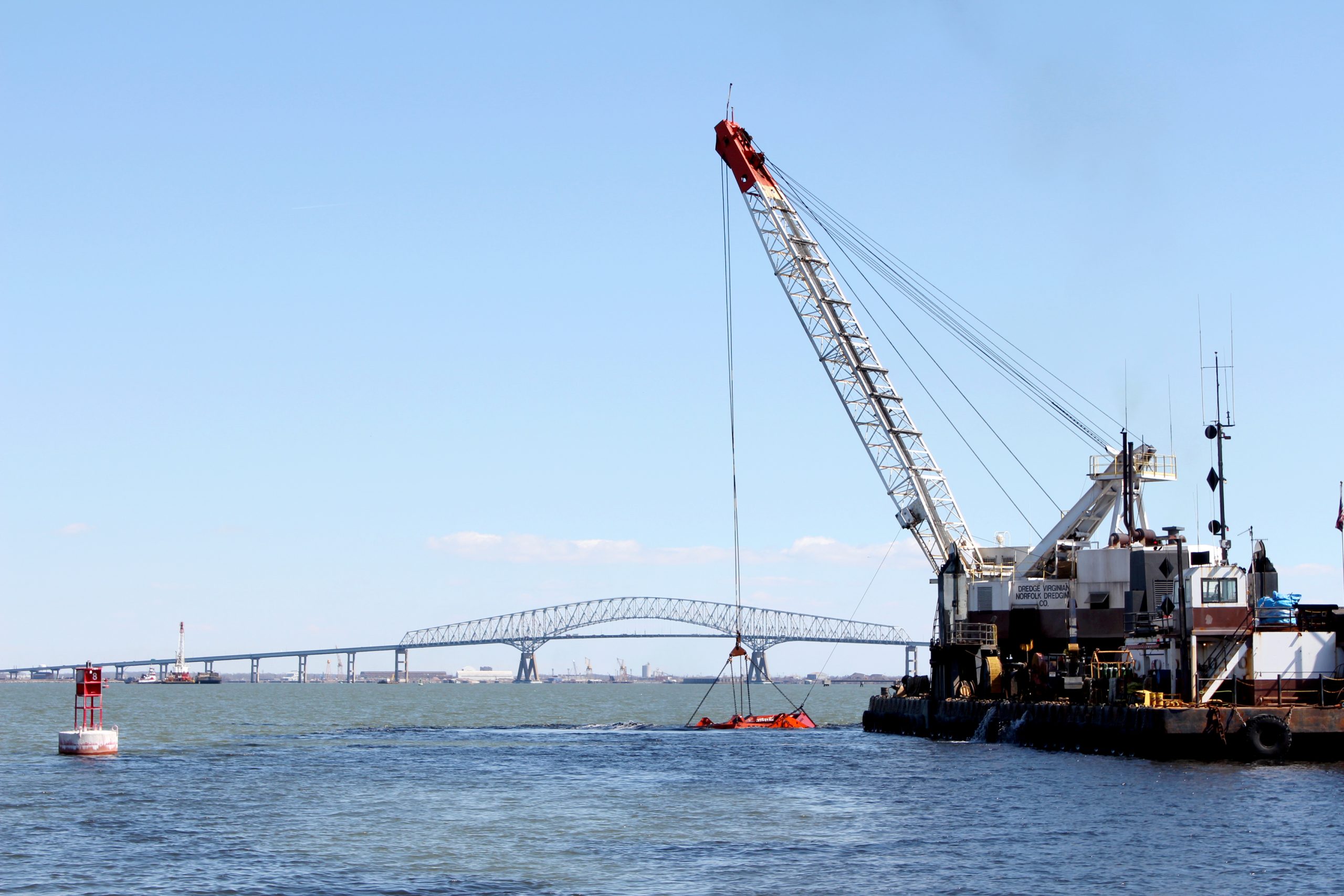In April, Norfolk Dredging Company (NDC) finished dredging 2.6 million cubic yards from the shipping channels leading to the Port of Baltimore. The U.S. Army Corps of Engineers Baltimore District awarded the $24.6 million contract. Work began in December 2018 and was completed on April 14.
The work is part of the regular maintenance of the multiple channels that go from the mouth of the Chesapeake Bay in Virginia into Baltimore Harbor. The current project dredged material from six federal channels.

The channels were dredged to 51 feet and vary in width from 400 to 700 feet. Cutoff Angle was last dredged in 2014, Craighill Upper Range in 2009, Craighill Angle in 2017, Craighill Channel in 2007, Craighill Entrance in 2016, and Curtis Bay in 2009.
Corps Baltimore District Project Manager Jeremiah Spiga said the channels generally shoal about two feet or more along the outside quarter of the channel.
Norfolk Dredging did the work with two Cable Arm clamshell bucket dredges, the 38-cubic-yard Atlantic and the 30-cubic yard Virginian. The Vicksburg, a 24-inch hydraulic barge unloader; two, 4,500-cubic-yard hopper barges (scows); three, 6,500-cubic-yard scows; one 6,000-cubic-yard scow, three tender tugs, four to five tugs, a support tug, drag barge and two crew boats joined the dredges on the project.
Norfolk Dredging also brought various land based equipment, including thousands of feet of HDPE pipeline, recirculation pumps, bulldozers, front-end loaders, extended boom forklifts, generators, air compressors and welding machines.
The material consisted mainly of mud, silt, sand and shell and was placed at two sites. Norfolk Dredging placed approximately 500,000 cubic yards of material from Curtis Bay Channel at the Masonville Dredge Material Containment Facility (DMCF), located in Anne Arundel County. Approximately 2.1 million cubic yards of material dredged from the Chesapeake Bay channels, including the Craighill Entrance, Craighill Channel, Craighill Angle, Craighill Upper Range and the Cutoff Angle channels, was beneficially reused at the Paul S. Sarbanes Ecosystem Restoration Project at Poplar Island, located in the eastern Chesapeake Bay near Tilghman Island in Talbot County, Maryland.
Mike Bushery, Norfolk Dredging project manager, said the dredged material was loaded by the clamshell dredges into the scows and then towed by tugboats to the disposal sites, where the Vicksburg unloaded the barges.
The Poplar Island site was about 25 to 35 miles away from the dredging site. The average tow distance to Masonville DMCF was about 1.5 miles. At Masonville, Norfolk Dredging could not pump slurry water from the bay, so it used recirculating pumps.
“Early on in my career with NCD, I was on the project that helped build the Masonville DMCF. It was great being able to see the area again and how much it’s changed,” Bushery said.
At Poplar Island, Norfolk Dredging placed material at four different discharge points in three cells to facilitate testing being done by the Corps at the site.
The dredges worked simultaneously in the channels. “In the lower bank areas, we only kept one dredge in a section because it would go fast. The dredges teamed up on the angles because there was more bank and enough room for both dredges to work together, without being on top of each other,” Bushery said.
He said one of the biggest challenges for the project was logistics and coordination. “It takes a lot of moving parts, spread out over 35 miles by water (1.5-hour drive by land), to make the dredging and unloading process come together. While it’s all one project, you basically have three separate work areas operating simultaneously. With the extensive amount of equipment and personnel, it’s hard to keep everything running smoothly, and a breakdown at one of the three sites affects the rest of the project. For instance, if the unloader breaks down, or if it’s too rough to unload scows, then the dredges shut down a few hours later because all the hopper barges get filled but have nowhere to go. And vice versa, if a dredge breaks down then we’re not feeding the unloader enough to keep it operating, and it shuts down for large parts of the day or longer,” Bushery said.
Work in the Northeast during the winter is usually challenged by extreme cold and rougher seas than the summer months. Bushery said the weather was fair, but the project experienced its fair share of “nasty days.”
He said when Norfolk Dredging performed maintenance dredging in the channel in 2014 and 2015, the entire bay froze solid from the C&D Canal to south of the Bay Bridge, which shut the project down for about 20 days.
“On this project, I commend our entire team for doing an excellent job of safely, overcoming the many hazards of performing heavy construction in the harsh marine environment, including winter weather,” Bushery said. In total, the project logged more than 160,000 exposure hours without accruing a single lost-time injury.
“Whether people realize it or not, the Port of Baltimore is one of the key economic engines for Baltimore, the state of Maryland and really the whole region, and maintaining shipping channels like we’re doing with this work is extremely important,” said Baltimore District Commander Col. John Litz. “We’re happy to be able to carry out dredging on six channels this year coordinating closely with our partners in the Maryland Port Administration to maintain the depths of these vital channels and ensure the port of Baltimore can continue to serve the region.”
The Baltimore District works closely with the Maryland Port Administration (MPA) on projects in the channels and harbors. “A significant part of [MPA’s] role is to help coordinate for placement sites for the material. They are a cost-sharing partner in the Paul S. Sarbanes Ecosystem Restoration Project at Poplar Island and work closely with the Maryland Environmental Service, who perform day-to-day operations on the site,” Spiga said.
The Masonville Dredged Material Containment Facility, where material dredged from the Inner Harbor area was placed, is an MPA facility.
Funding for the project came from fiscal year 2018 (FY18) Corps annual funds. Poplar Island Construction General (CG) FY18 funds were used for approximately 45 percent of the dredging work for material that was sent to Poplar Island.
The Baltimore District expects to award another dredging contract later this year for the removal of material from the York Split Channel, an approach channel for the Port of Baltimore in Virginia waters of the Chesapeake Bay.
In 2018, the U.S. Department of Transportation also dedicated $6.6 million in grant funding for a project to deepen a second container berth to 50 feet at the Seagirt Marine Terminal. The State of Maryland will contribute $7.8 million and Ports America Chesapeake, which operates the Seagirt Marine Terminal, will add $18.4 million for a total project cost of about $32.8 million.
The Port of Baltimore had a record year in 2018, handling 10.9 million tons of general cargo. Container was also a record for 2018, at 1,023,152 TEUs (twenty-foot equivalent units), up six percent from 2017.



